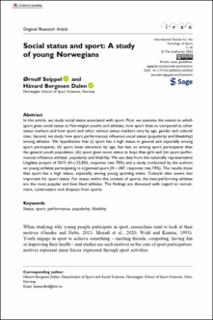| dc.contributor.author | Seippel, Ørnulf Nicolay | |
| dc.contributor.author | Dalen, Håvard Bergesen | |
| dc.date.accessioned | 2024-01-04T15:18:22Z | |
| dc.date.available | 2024-01-04T15:18:22Z | |
| dc.date.created | 2023-10-14T13:25:13Z | |
| dc.date.issued | 2023 | |
| dc.identifier.citation | International Review for the Sociology of Sport. 2023, Artikkel 10126902231202924. | en_US |
| dc.identifier.issn | 1012-6902 | |
| dc.identifier.uri | https://hdl.handle.net/11250/3109895 | |
| dc.description | This article is distributed under the terms of the Creative Commons Attribution 4.0 License (https://creativecommons.org/licenses/by/4.0/) which permits any use, reproduction and distribution of the work without further permission provided the original work is attributed as specified on the SAGE and Open Access page (https://us.sagepub.com/en-us/nam/open-access-at-sage). | en_US |
| dc.description.abstract | In this article, we study social status associated with sport. First, we examine the extent to which sport gives social status to Norwegian youths and athletes, how sport does so compared to other status markers and how sport and other various status markers vary by age, gender and cultural class. Second, we study how sport performances influence social status (popularity and likeability) among athletes. We hypothesise that (i) sport has a high status in general and especially among sport participants, (ii) sport loses attraction by age, but less so among sport participants than the general youth population, (iii) sport gives more status to boys than girls and (iv) sport performances influence athletes’ popularity and likability. We use data from the nationally representative Ungdata project of 2015 (N = 22,856, response rate 70%) and a study conducted by the authors on young athletes participating in organised sport (N = 387, response rate 74%). The results show that sport has a high status, especially among young sporting males. Cultural class seems less important for sport status. For status within the context of sports, the best-performing athletes are the most popular and best liked athletes. The findings are discussed with regard to recruitment, continuation and dropout from sports. | en_US |
| dc.language.iso | eng | en_US |
| dc.subject | likability | en_US |
| dc.subject | performance | en_US |
| dc.subject | popularity | en_US |
| dc.subject | sport | en_US |
| dc.subject | status | en_US |
| dc.title | Social status and sport: A study of young Norwegians | en_US |
| dc.type | Peer reviewed | en_US |
| dc.type | Journal article | en_US |
| dc.description.version | publishedVersion | en_US |
| dc.rights.holder | © The Author(s) 2023 | en_US |
| dc.source.pagenumber | 18 | en_US |
| dc.source.journal | International Review for the Sociology of Sport | en_US |
| dc.identifier.doi | 10.1177/10126902231202924 | |
| dc.identifier.cristin | 2184705 | |
| dc.description.localcode | Institutt for idrett og samfunnsvitenskap / Department of Sport and Social Sciences | en_US |
| dc.source.articlenumber | 10126902231202924 | en_US |
| cristin.ispublished | true | |
| cristin.fulltext | original | |
| cristin.qualitycode | 2 | |
